F
FishingMagic
Guest
Dave Coster – Forgotten Floats
BODIED WAGGLERS
Browsing through the vintage float sets on the Thomas Turner website brought back memories of when I first started fishing, recalling quills, perch bobbers, and various other golden oldies. Last year I enjoyed several interesting sessions using another classic float you rarely encounter in tackle shops these days: the bodied waggler. I’ve occasionally seen semi-weighted versions employed as sliders, but a once popular application was to have them fixed, for fishing long range on big stillwaters. I did this a lot in Ireland, but due to various circumstances I haven’t been there for a while. However, last year a mate told me about a venue that offers an uncanny similarity to wild Irish lough fishing, only it’s 10 minutes’ drive from East Midlands Airport. Grabbing a handful of my favourite bodied peacock quills, it dawned on me some are well over 30 years old now. I also dusted down my groundbait catapults, waders and platform, gear that had been lying idle for far too long.
DUAL ATTACK
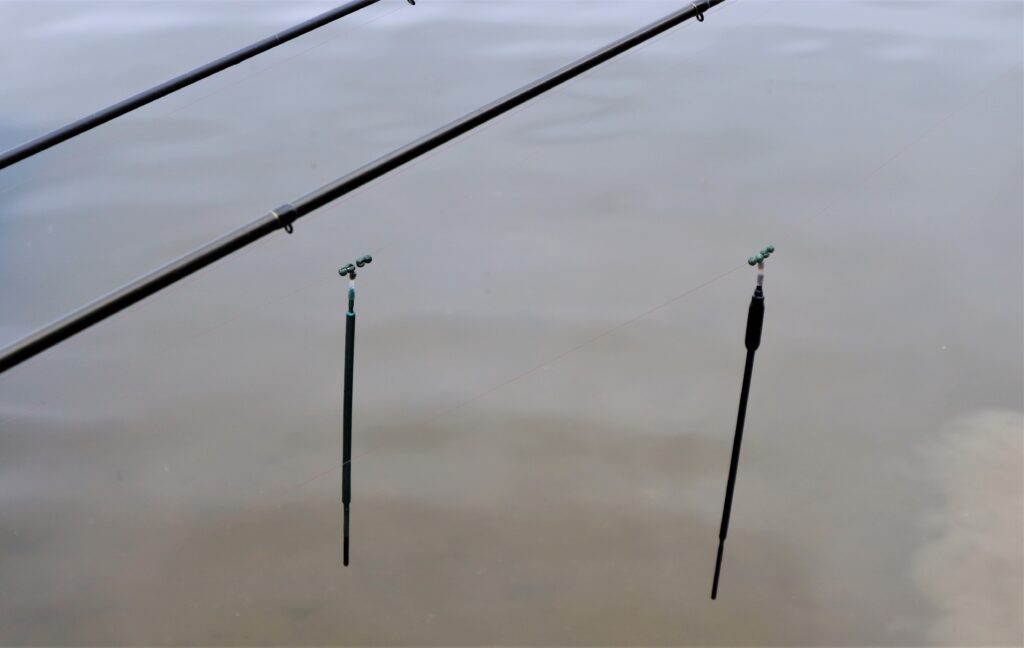
Staunton Harold Reservoir turned out to be perfect for a big waggler attack. Most anglers choose to fish feeder tackle at extreme range for the bream shoals. But the place is heaving with roach and skimmers, which signals busy float sessions to me. On my first visit I set up two waggler rigs. The first was a traditional bodied model to explore further out, while the second was another classic, an insert peacock design for closer in. Both floats were locked on the main line with two big shot either side. My plan was to kick off with the bodied float a good way out, feeding small balls of groundbait by catapult. My lighter set-up was there if I decided to try loose feeding. Big roach often move closer in as sessions progress, preferring the rocky margins on exposed venues, where they feel a lot safer from predators. Get them within loose-feeding range and it’s often possible to cane them. This is another Irish tactic, building a distance swim, and then channelling the fish closer in.
WORKING IT OUT
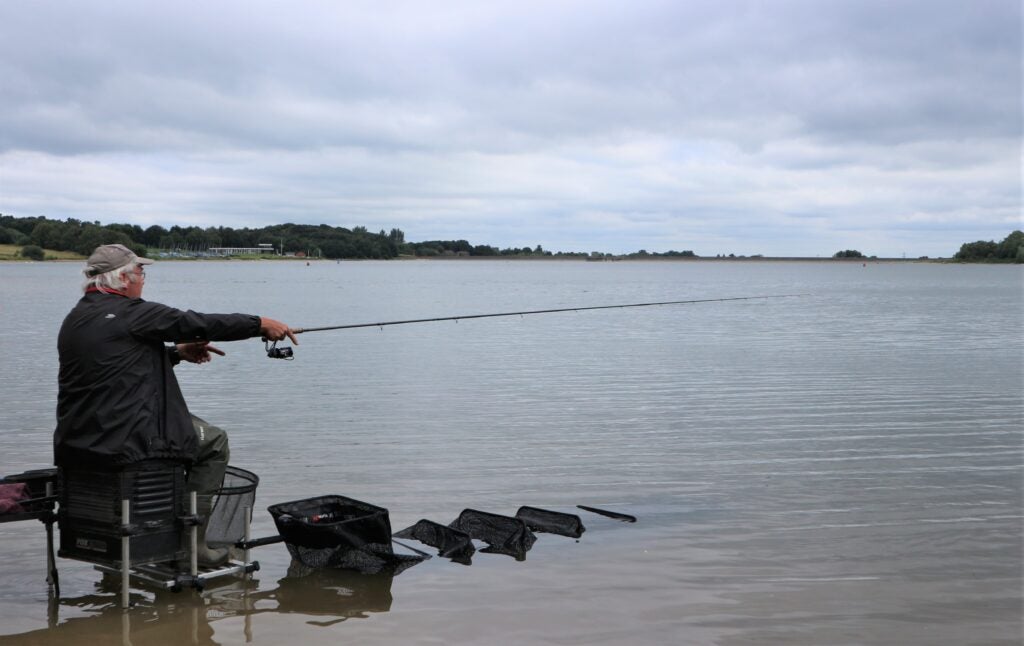
It pays to spend time searching your swim before fishing with big wagglers at long range. In venues with shallow margins like this one, finding any far-off ridges or ledges where the depth shelves away can make a huge difference. Fish patrol such areas and feed more confidently in them, feeling safer than when they are in open water. I push my hook into a small piece of tungsten putty to depth-find with waggler rigs, finding conventional plummets too heavy to cast properly with bottom-attached floats. Once I know the depth and how far out I’m going to fish, another top trick before putting any feed in, is to bait up and cast out a few times. As you work the tackle through the swim, it lets you know where any surface drift or tow is going to take everything. Very often you need to fish over-depth to keep the hook bait still, so it can take several yards for rigs to settle properly. There’s no point in feeding first and then finding you can’t hold your float in that particular spot!
WHOPPER DROPPER
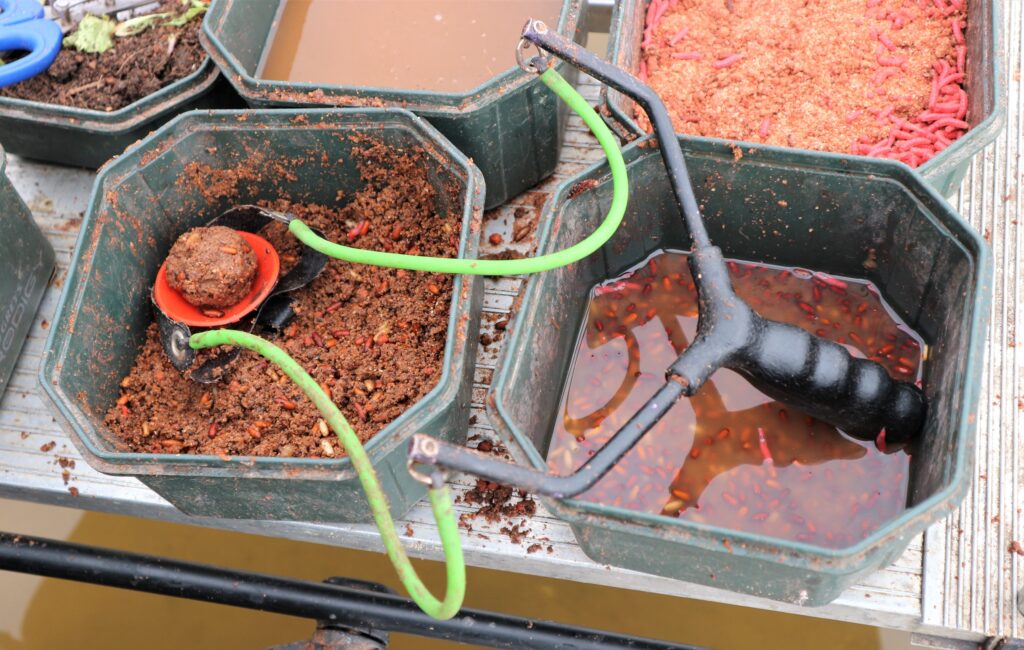
I’ve experimented with many groundbait catapults over the years, and still don’t think you can beat the original Whopper Dropper, another piece of classic kit. This wide-gape catty and its rigid cup, set in a cradle-style pouch, allows soft balls of groundbait to be fed without breaking up in flight. This is perfect for big waggler fishing. Softer balls of feed disperse as they descend in the water, leaving a secondary lingering cloud, which is far more effective than feeding hard rocks! This tactic keeps the fish interested and grubbing around for longer, also being less likely to spook a feeding shoal. I don’t mind if some groundbait drops a tad short occasionally, because I can check this area out with my lighter insert waggler set-up as the session progresses. If I get bites there, I can try loose feeding, which is often a great way of ending sessions, catching a bigger stamp of roach. With my groundbait approach, I constantly flick water over the mix to keep the balls on the soft side.
CHANGING MENUS
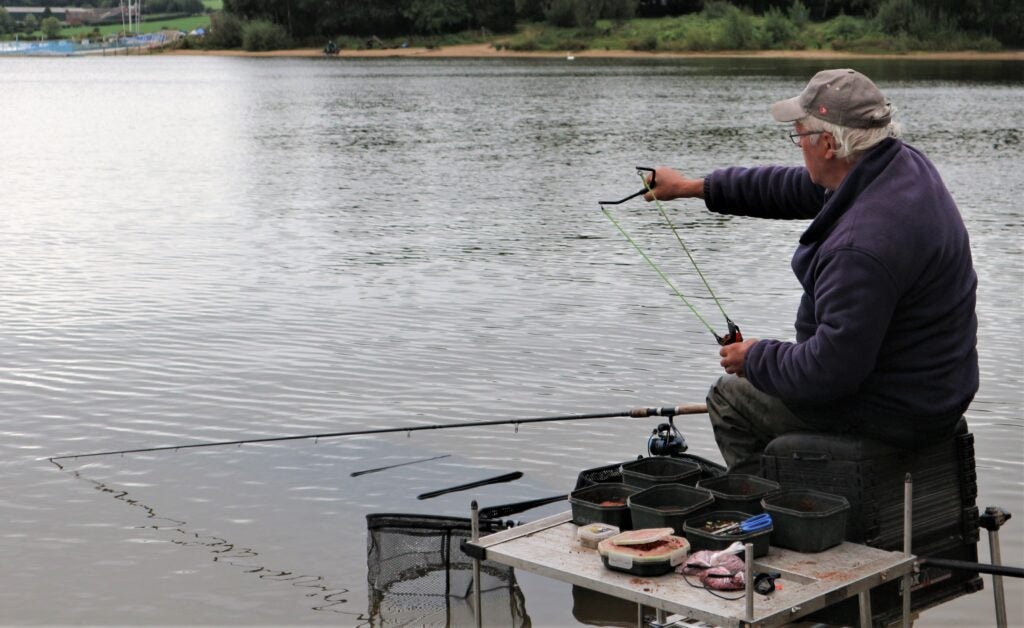
It’s advisable to carry a good selection of bait when exploring big expanses of water with bodied wagglers. I kick off with dark groundbait, heavily laced with casters and hemp. If any skimmers turn up, I can always add some chopped worm and pellets. I find pellets can help if small fish are a problem, feeding less casters and putting extra doses of 2-4mm pellets into my groundbait. I might also experiment with soft hookers. Bream, skimmers, roach and hybrids will all happily accept these, bearing in mind a lot of feeder anglers use pellets and fishmeal groundbaits these days, especially when targeting bream. To begin sessions, I feed small balls of groundbait every chuck, but once bites start coming, I tend to make it every other cast. It all depends on how the fish are responding. Roach normally stay put once they get used to regular groundbait going in, but skimmers and bream often require a less frequent groundbait approach, being easily spooked in shallow water.
ALL ACTION
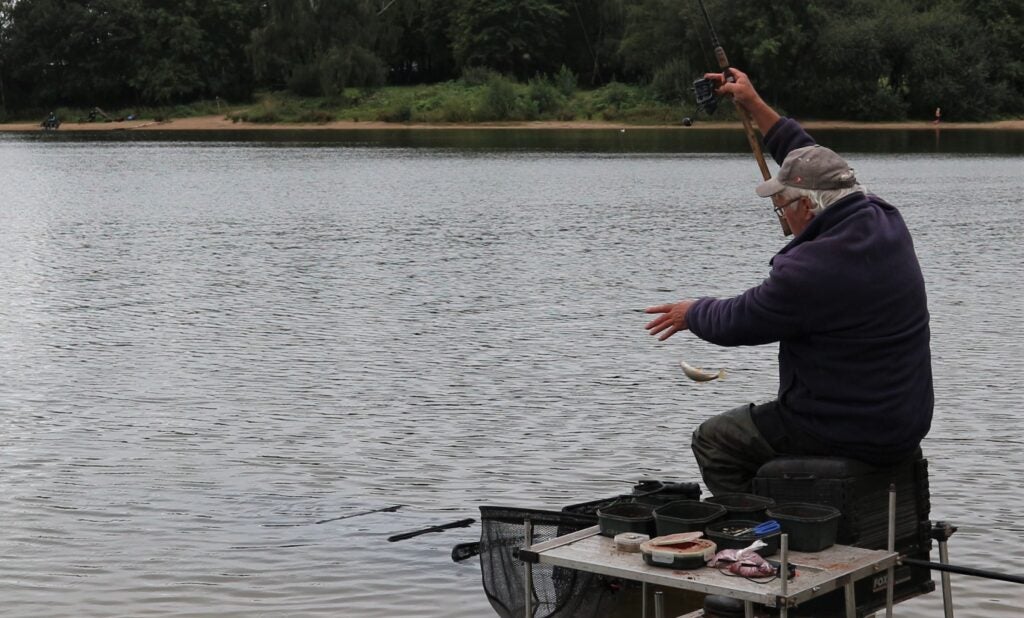
It quickly became clear why this reservoir is so popular. As soon as some feed started going in it was virtually a bite a chuck, but the trick was finding how to connect with the bigger fish. Typically for a clear-water venue, the better-sized roach were masters at giving phantom bites, where the float tip slowly went under and nothing was there on the strike. But it soon became apparent my big-bodied wagglers hadn’t lost any effectiveness over the decades. I had to fish well over-depth, with my lowest dropper shot dragging hard on the bottom to steady the hook bait. Double red maggots pulled too many small fish, but a switch to single dark casters brought a better stamp of roach and hybrids. The same pattern emerged over three different visits, where the trick was to try and get hook baits through the bits, casting a few yards from where any groundbait was going in, then letting the tow pull the tackle into the taking area. Soft, dark pellets pulled bites too.
STILL EFFECTIVE
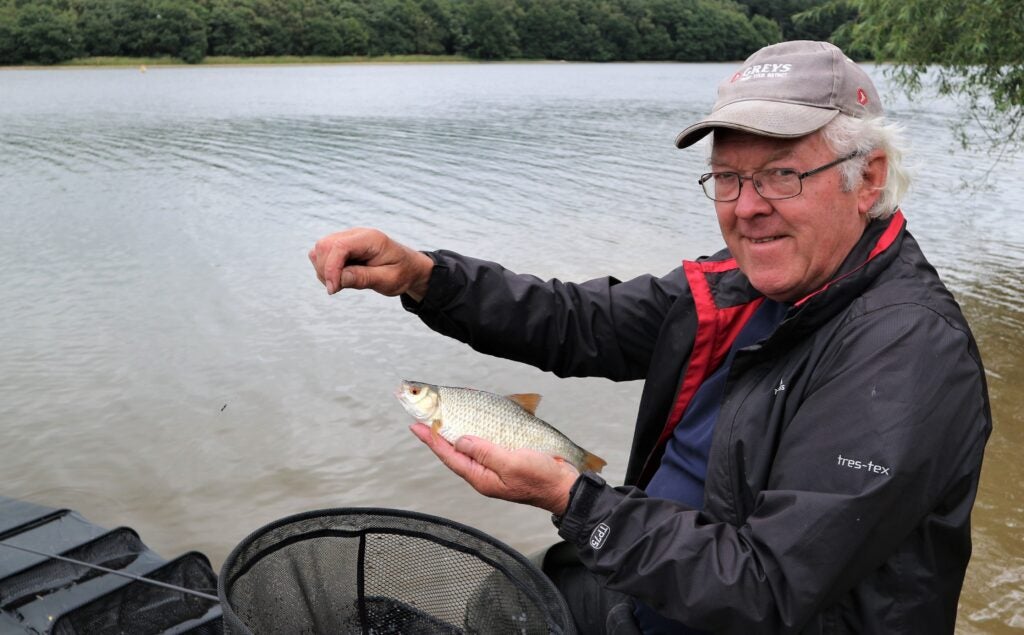
The last time I enjoyed quality waggler fishing with this tactic was across the Irish Channel several years ago, fishing Cork’s Inniscarra Reservoir. Pristine red fins provided great sport at a hectic rate back then and I caught some cracking fish. I found a similar attack with small balls of catapulted groundbait worked the same here. On my first bodied waggler outing I also managed to loose feed over the top, because the wind was from behind. But my swim choice turned out to be very shallow, just 4 feet deep. Fish were there, but no real chance of skimmers or bream in that depth. I caught steadily though. Towards the end I plundered some bigger roach on the insert waggler, dragging well over depth – several metres closer in than where I started. On my next trip, I picked a deeper area and managed to keep fish coming all day on the distant bodied waggler feed line, hoping for bream to turn up. They didn’t, and it was mainly roach again, plus a few surprise dace.
HOOKED AGAIN
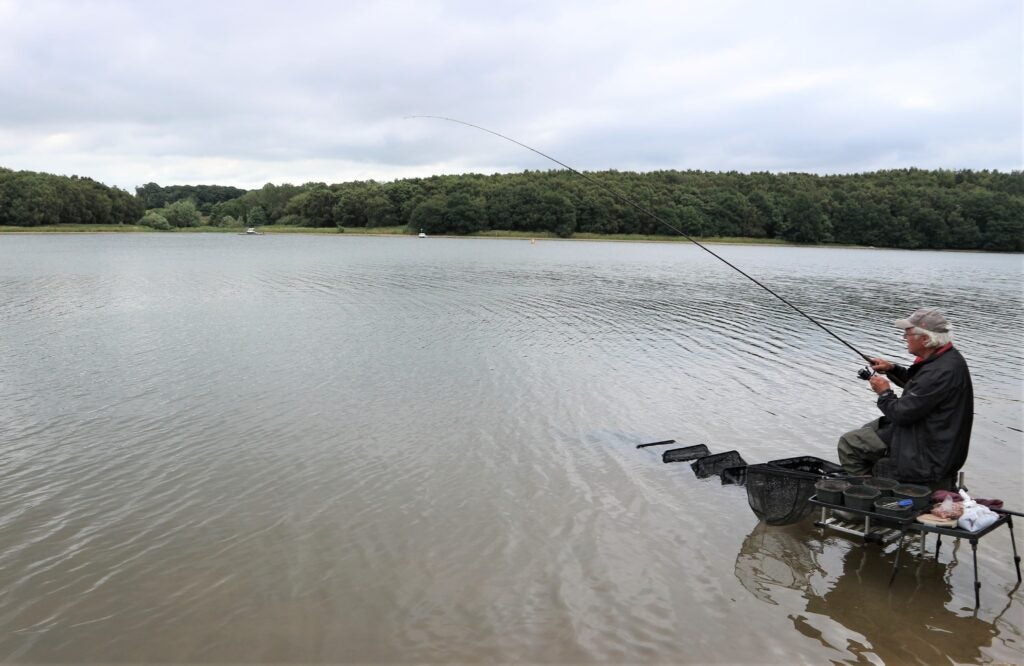
I managed a final trip to the reservoir before winter descended, by this time completely absorbed by this bodied waggler technique. It’s a positive way of fishing that gets in your blood. It takes time getting back in the swing of putting balls of groundbait within inches of your float tip, or just ahead of it when you need to let any drift shift your rig into the taking area. Because this venue was shallow, I found a 13ft float rod ideal. For deeper water and similar slider fishing at distance, I would have no hesitation switching to 14ft or even 15ft rods. I often use the same semi-loaded bodied wagglers for fixed fishing as I do for slider applications. With some weight built into these floats, you don’t need massive amounts of shot to lock them, avoiding making rigs over-complicated. I have doctored many of my bodied floats, aralditing in connectors, so different coloured hollow tips can be switched around to suit light conditions. Yet another action-packed session followed.
IN THE BEGINNING
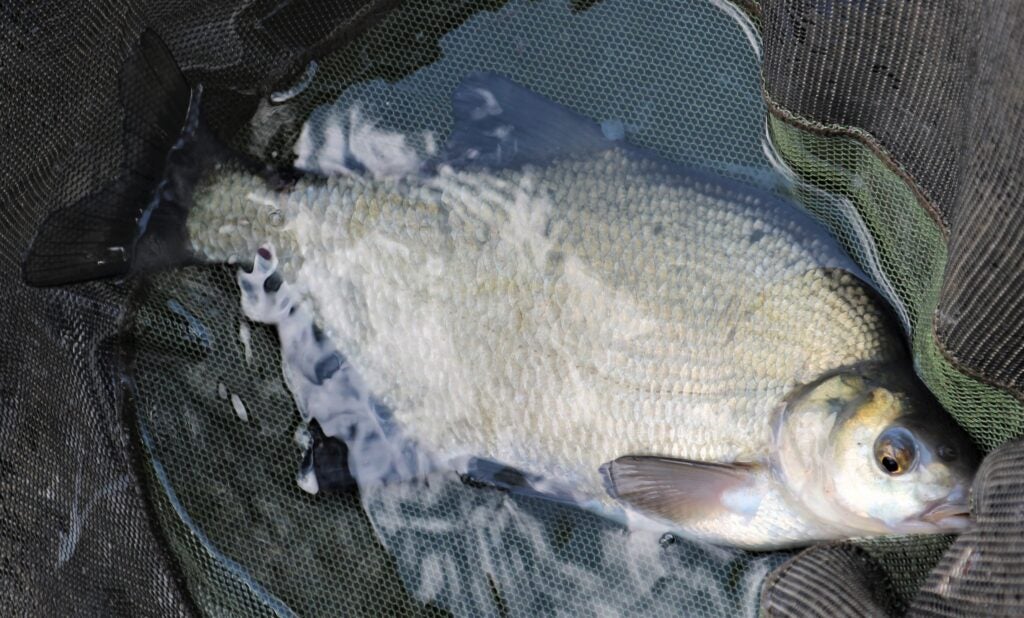
In many cases, modern pellet wagglers and carp splashers have replaced good old bodied wagglers, which were even used for carp many years ago. I remember Bob Cheeseman, a fellow Essex County team member, landing some massive carp with them on Layer Pits. Even before that, during my club fishing days, I recall being pegged opposite a top angler on a lake at London Colney, watching the guy expertly casting a bodied waggler next to a far-off lily bed. He made it all look so easy as he cranked in bream after bream. It was an education. Since then, over several decades I have built up a good collection of bodied floats, some home-made, some doctored, some shop-bought, some crafted by other anglers. As I mentioned earlier, they were mostly used when I regularly visited Ireland, so I’m a bit like a kid in a toyshop now I have rediscovered these floats. Some are works of art and like JB says, a bit scary to use in case they get lost. This good skimmer was taken on one.
GETTING THERE
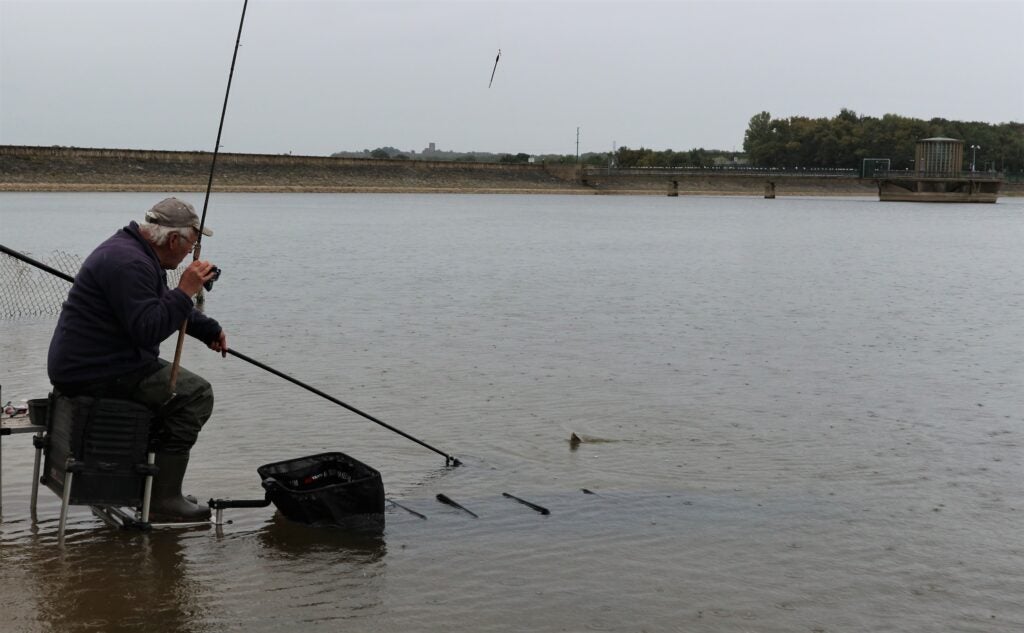
While my rediscovered attacking floats couldn’t line the skimmers and slabs up on the reservoir, I did plunder the roach stocks. Catching quality red fins is tricky on many cormorant-ravaged big stillwaters these days, but somehow the fish here were managing to survive. Maybe having plenty of anglers about was a plus factor, along with the sailing club that was possibly helping to keep the predators at bay. My final session at Staunton Harold, which is a day ticket water, turned into another bite a chuck experience. Once again, casters found the better roach, but they wouldn’t come within loose feeding range. It had to be groundbait: every cast to quickly bring the peg alive, then every other cast when things were ticking over. I tried worms and caught that one good skimmer, but possibly wasn’t quite bold enough, not going far enough out to string more together. But now I’ve got back in the swing of it, I reckon I can push this method much further.
BAGGING UP
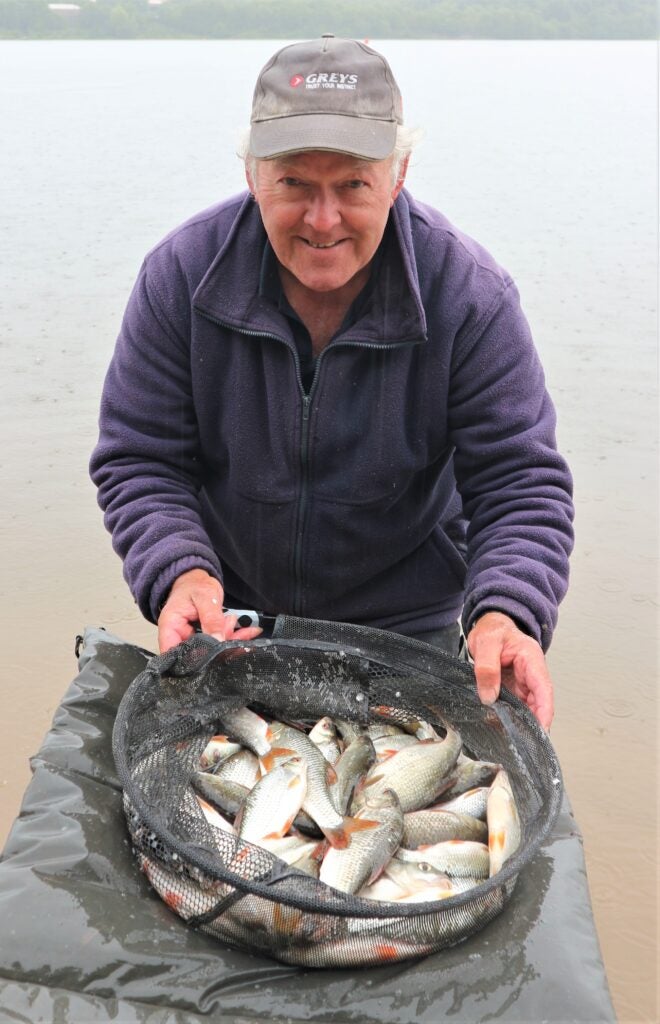
I had forgotten how good bodied waggler fishing could be. I spent many years up North, where all my big semi-weighted designs could only be used as sliders, because all the larger venues were too deep for fixed floats. But now I’m living in the Midlands, there are plenty of shallower places where I can use the method again. Getting back in the groove of casting and catapulting groundbait accurately at extreme waggler range brings a satisfying feeling, especially when a decent bite develops nearly every time. It’s a busy way of fishing, as you can see from this catch of mainly quality roach. Nowadays, just about everyone on big venues is casting to the horizon with feeders, so I wonder if largely forgotten floats, like I’ve been using, might make a comeback? I certainly keep a good supply in with my gear now, looking forward to using the method a lot more. I did manage another session, on a venue with better chances of finding bream within range of my groundbait catty…
WORKING WONDERS
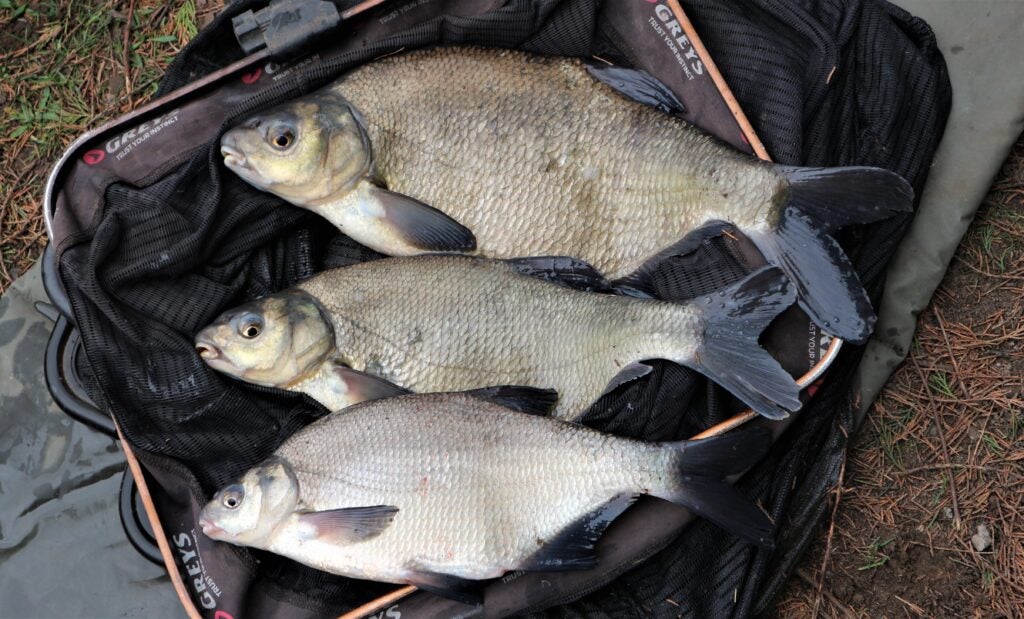
Yet another big stillwater, with sensible depths of around 6-8ft, was perfect for a fixed bodied waggler attack. Apart from this fine trio, I also caught loads of roach, hybrids and smaller skimmers, for a smashing net of fish. Rediscovering forgotten floats has highlighted they can still work perfectly well. Other golden oldies in my collection include some Benny Ashurst and early Pete Warren sticks, remember those? I also have some Tom Pickering peacock inserts, one or two Billy Makin Canal Greys, a few Image Canal Wagglers and even some old Middy specials with my name printed on them. I can’t remember what that was about! Peter Drennan is another great float maker and I still have his early Crystal Wagglers, along with Merged Peacock inserts, which were best sellers for many years. And yes, JB, I too have used matchsticks and bits of quill along the way!
John Bailey – My Way with Floats
My very early angling life in the Fifties revolved around floats, like everyone’s did, come to that. Legering was seen as iffy, lazy, a poor substitute for the real thing and as a last resort. We all remember the tackle shops of the day, counters a colourfully resplendent feast of jars packed with quills of all sorts and sizes, floats for every occasion. If you could afford them. Most sessions began with my mates and me rummaging on the canal towpaths looking for half-decent matchsticks to do the job, both cheaply and efficiently, as it happened. Then, by the later Sixties and into the Seventies as floppy hats, forceps and specimen hunting came in, floats somewhat went out. It wasn’t until the later Nineties and this century that I personally came back to floats with such a gleeful vengeance. In part this was because, as a guide, my clients in the main preferred to float fish, but then I too began to see the sense in the reversion. Float fishing is inherently “nicer” than legering, more engaging, more appealing, more all-consuming. It is efficient as well, and there is truly a float for every occasion, and that knowledge is what gives the float its versatility, as I hope to prove today.
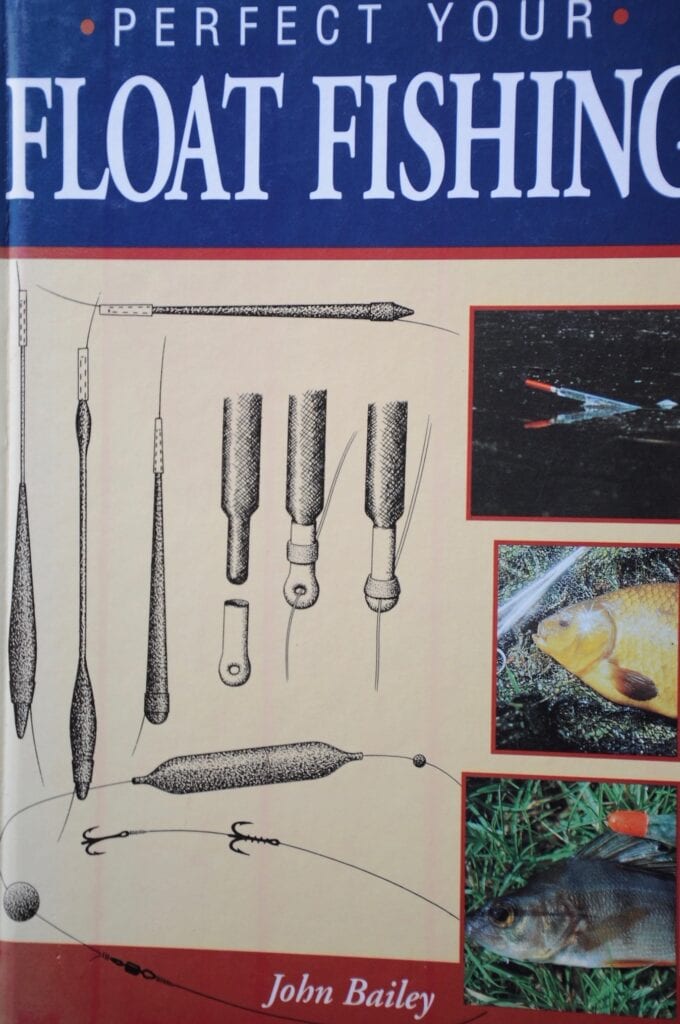
In the Nineties I wrote a little book called Perfect your Float Fishing and that hastened my conversion back to the true faith. I was helped massively by float maestro Peter Drennan, so I had the way paved for me magnificently. Since then, I have become friends with legendary float makers like Paul Cook, Ian Lewis and Andy Field, and many of my floats come from their workshops. Of course, like all of us, most of my floats are plastic Drennans, but there are specialised jobs where a float of individuality can make the task easier. Of course, there is the cost factor and I’m well aware it’s not good to lose a forty quid float up a tree first cast, then its twin on a weeded carp half an hour later but, honest, if I’m a couple of floats down at the end of an average season then that’s unusual. (Mind you, I’ll swim for a Field float if I have to!) eBay can cough up some gems, as can car boot sales, and there are some crackers on the Thomas Turner website. But I’m not in the business of selling floats for anyone here today, just talking about the more unusual floats that serve me well in an average season. And don’t forget, if you don’t have pork sausages for fingers like me, you can make your own floats too. I believe Ian Lewis sells kits to get you started, so if there ever is another lockdown – God forbid – you know how to spend it!
BIG WINDBEATERS
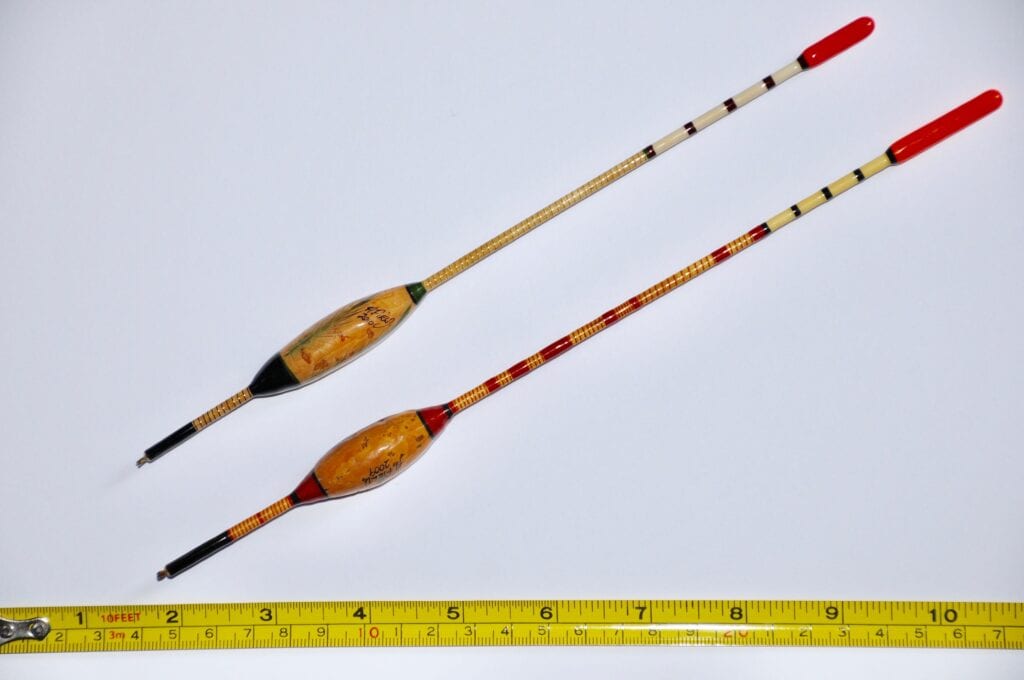
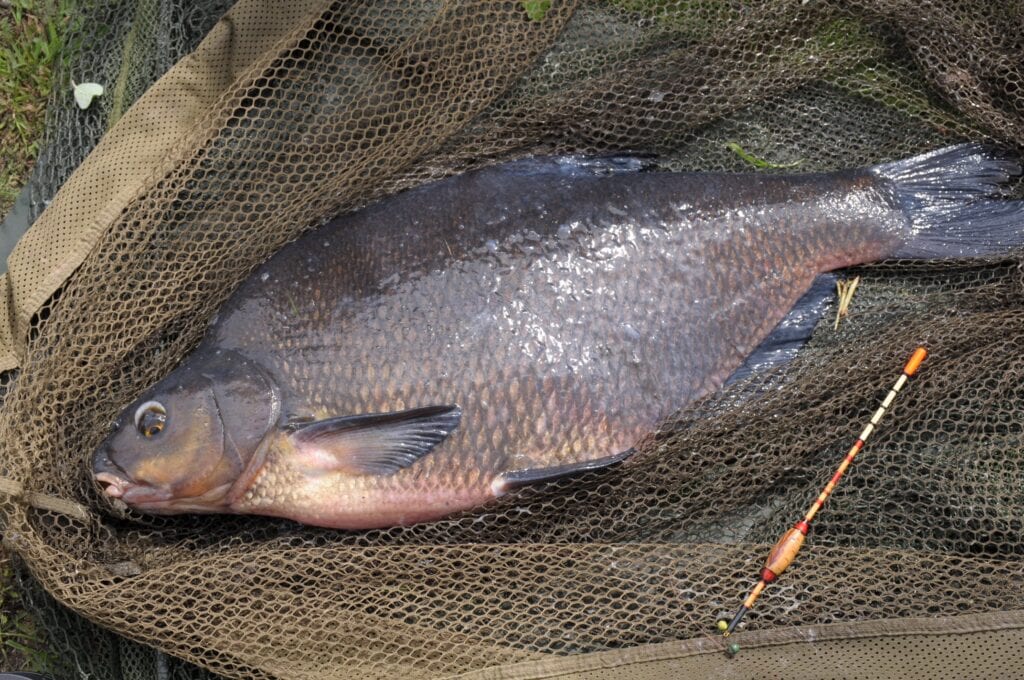
There are times when I prefer to fish a float at range rather than use a lead or feeder. Bream, roach, rudd, tench and carp even can get wary of the splash, and a float can present a smaller bait uniquely well. I first used these Field floats at Bucklands, the historic rudd water of a few years back. They didn’t catch me many rudd, but that was my ineptitude and not the fault of the tools. Since then, they have done me well for tench and bream at 30, even 40 yards distance, when both species have become twitchy around the lead.
LAYING ON IN BIGGER RIVERS
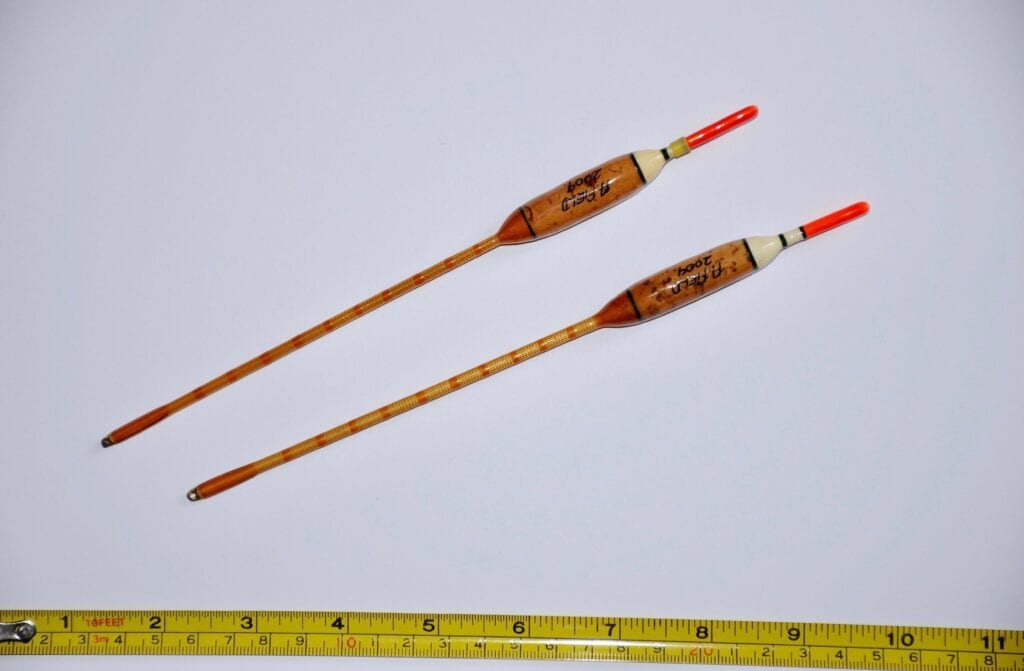
I am a slave to laying on in rivers. I was taught the method back on the river Dane around 1961-62, and it has caught me fish I would not get near since then. These floats are the size required for rivers of biggish flow and depth – I find them perfect for the Wye, for example. The key is the buoyancy up top that stops the float constantly sinking under the power of the current. You can get plastics to do the job, but these cane/cork creations don’t seem to skate in the same way, and hold position far better.
BIG SHOULDER STICKS
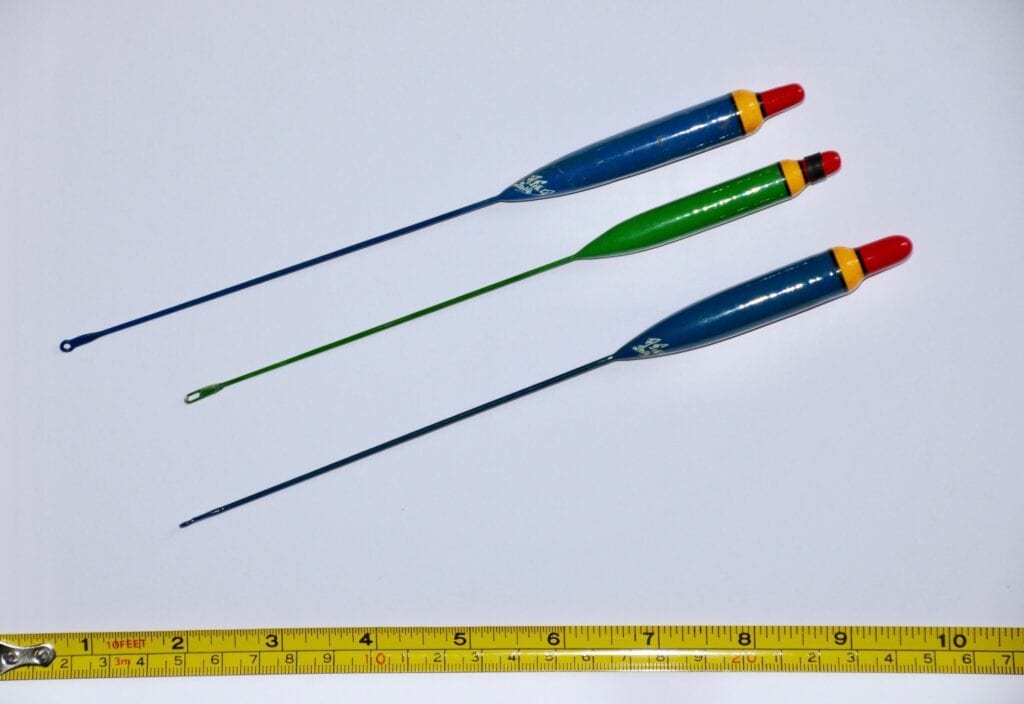
These are my go-to floats in quick, deep, turbulent water. The big shoulders prevent the float being pulled under repeatedly, and they give me something solid to mend the line against without pulling the float off course. They are perfect for chub and barbel both, and did me well on the Avon at Longford back in the happiest of days.
DOMED STICKS
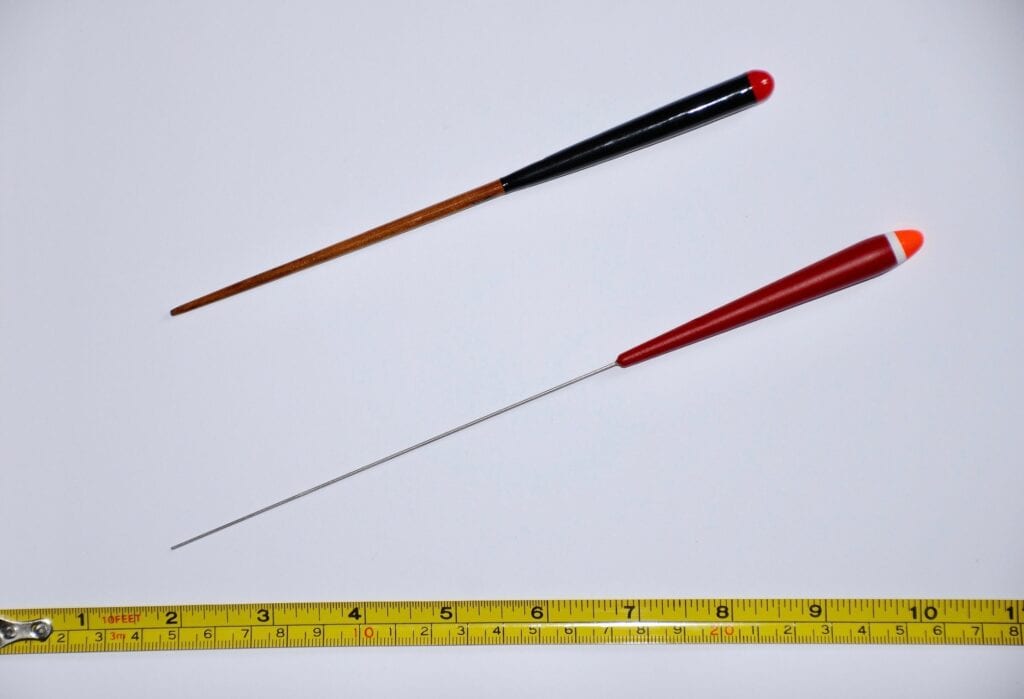
Andy Field made me a whole set of these beauties, and I have bought some more since, nearly as good. They work much like the Big Shoulders but are a little more sensitive, and great for smoother water. In their small sizes they worked well on very sensitive upper rivers like the Wensum, Bure and Yare. I have lost these, as it happens, and there are times I do miss them. It’s easy to get precious about floats and sound a real geek, but sometimes, small changes in model can make the difference.
IAN LEWIS AVONS
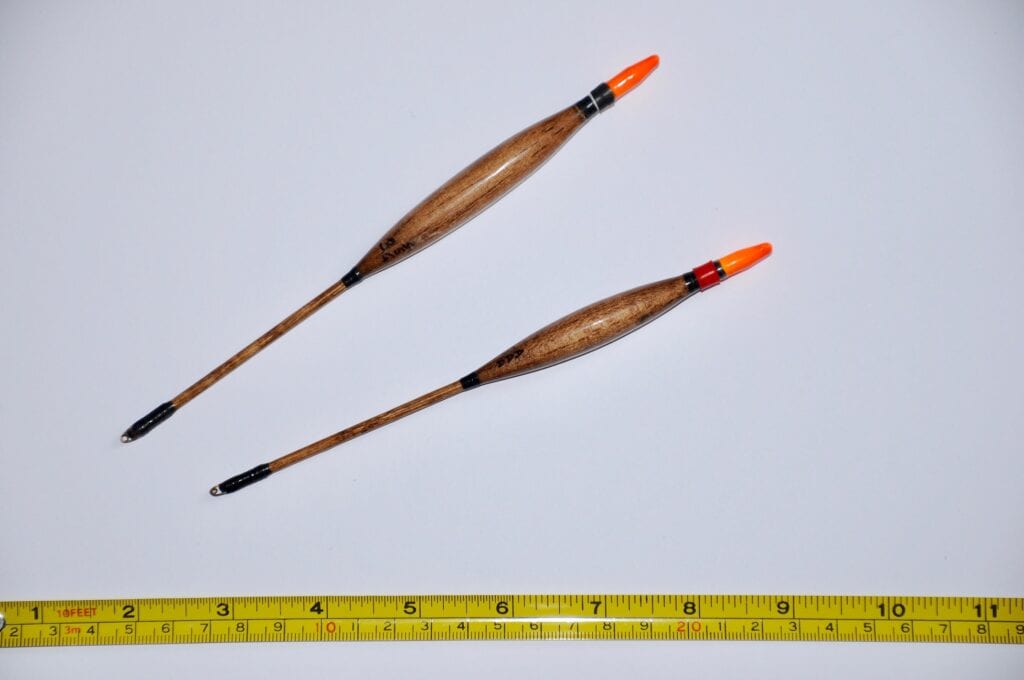
I fish these a lot. They are relatively inexpensive and I do lose a few fishing at range, especially when guiding them close to snags. But that’s their beauty, getting big slabs of flake forty yards down quick water 4 to 8 feet deep, and always maintaining control… well, most of the time anyway.
THE PHIL HUMM INFLUENCE
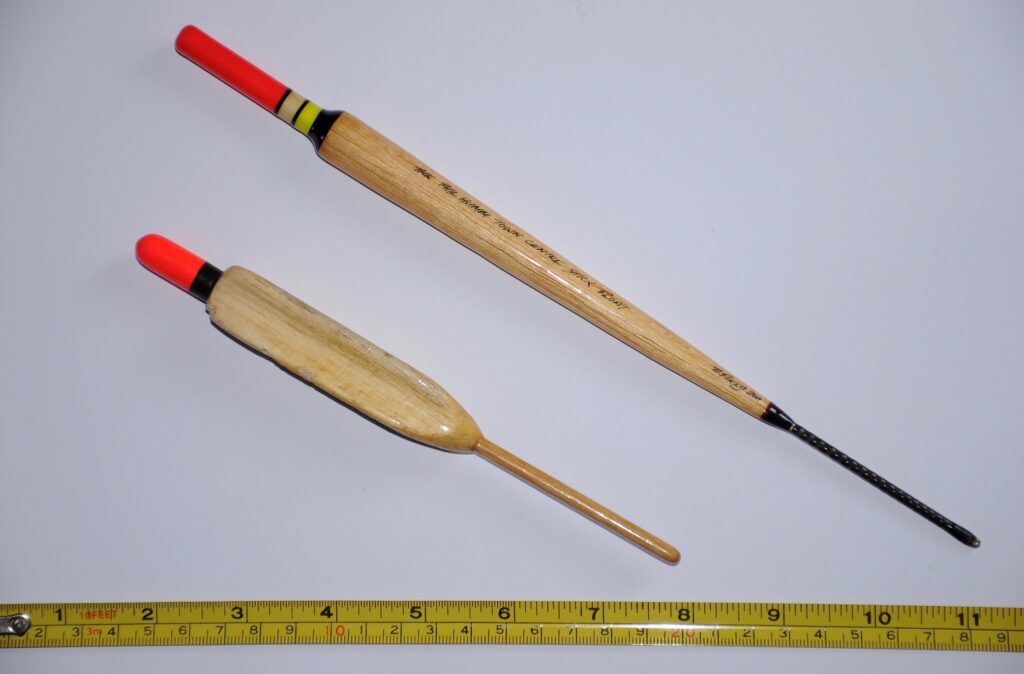
Phil is a dear friend and a cracking float man, and years ago made me the big, fluted balsa jobby in the photograph. I seem to remember it was made for a massive glide on the Wye where you needed to get big baits half the way to the sea to locate the chub. The thing takes half a dozen SSGs (at least), but you can see it and control it a mile off. I seem to recollect catching chub at a measured 80 yards plus the first time I tried it. Phil has never been afraid of using big floats if the job requires them, and that is why Andy Field made up the Phil Humm Town Centre Stick Float for him. God knows how much weight it takes as I have never actually used the thing, but I can see it working on the tidal Thames, for example. Didn’t the Trent Otter construct something similar for the lower Trent a century back, a creation that could carry nine ounces of weight or thereabouts? Men were certainly men back then!
IAN LEWIS REEDS
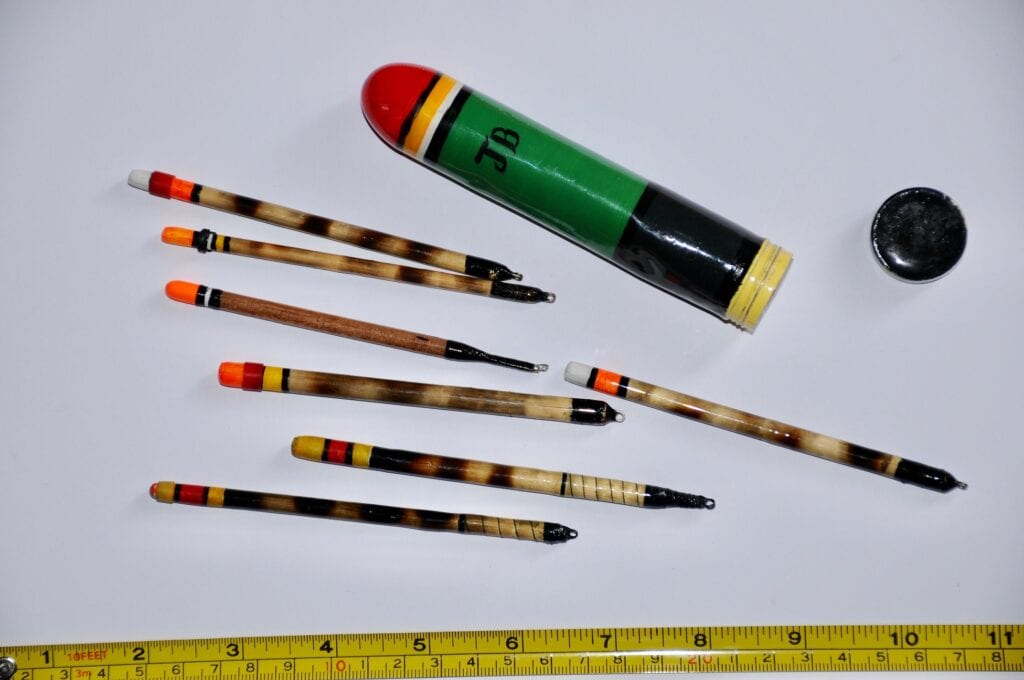
Ian made me a whole load of these nifty little reed floats, and put them in a dinky case that stops me losing them. Come summer, on little rivers, they are my go-to. Most take a BB, sometimes two, and you can tease them through quiet, shallow water beautifully.
ULTRA-LIGHT WENSUM WORK
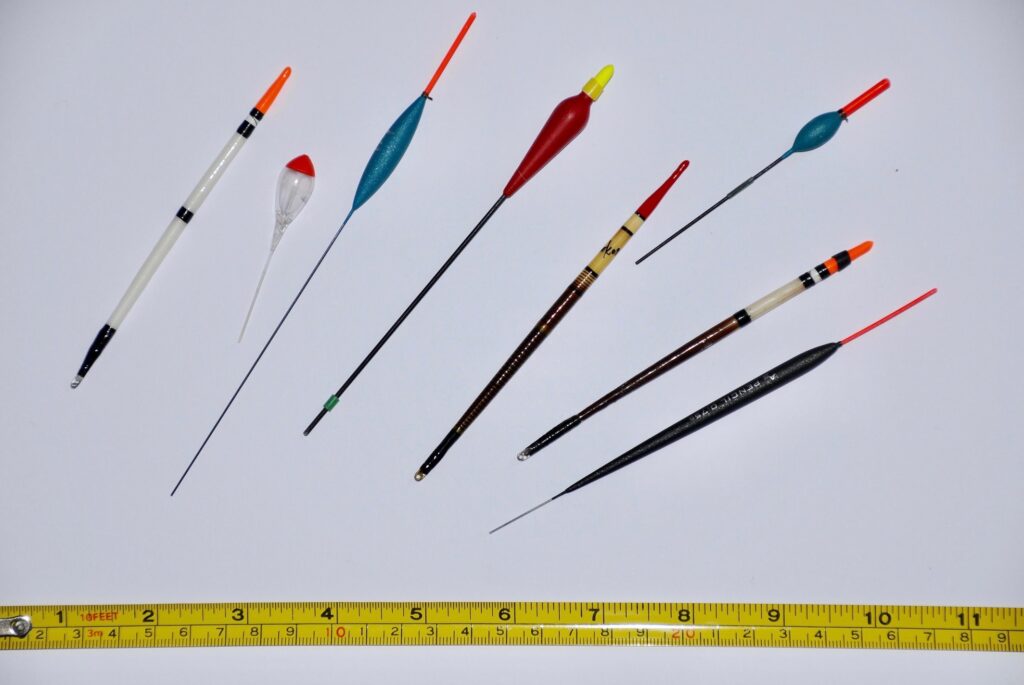
Mind you, there are numerous times when even these reed jobbies are too much. Ian made me some actual painted-up matchsticks that were brilliant, and took me back to the Macclesfield canal, but I have lost the damn things. Pole floats do as well, fished on running line in my case. Tiny quills. Often a number 6 shot is all the swim will stand, believe me.
NOVELTY NONSENSE THAT WORKS
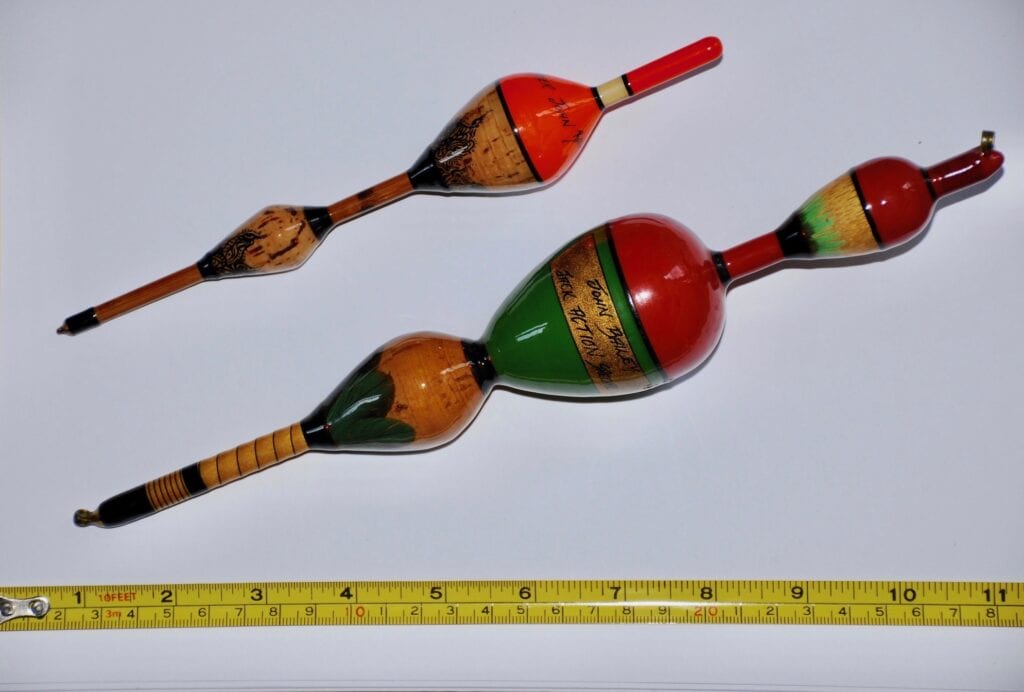
In 2012 I took Andy Field to India with me and he made these gorgeous floats up for everyone in the group… and wasn’t too excited to find a couple put on eBay shortly after our return. Anyway, they did serve a purpose and caught smaller mahseer by trotting balls of ragi paste anything up to 70 yards away. Fun! But it was the JB Jack Action Float that raised eyebrows! I had (and still have) a hunch that on some pike waters there are very big fish living unsuspected lives, simply because they have switched to a diet of smaller jacks. Of course, you can fish these on the bed, but there are times when a dead jack suspended is preferable. Naturally, use of this float was always a rarity, but when a dead jack turned up, often deeply hooked by someone and left to die in the margins, it had its moments. I can recall at least three big twenties coming its way.
LIGHT PREDATOR FLOATS
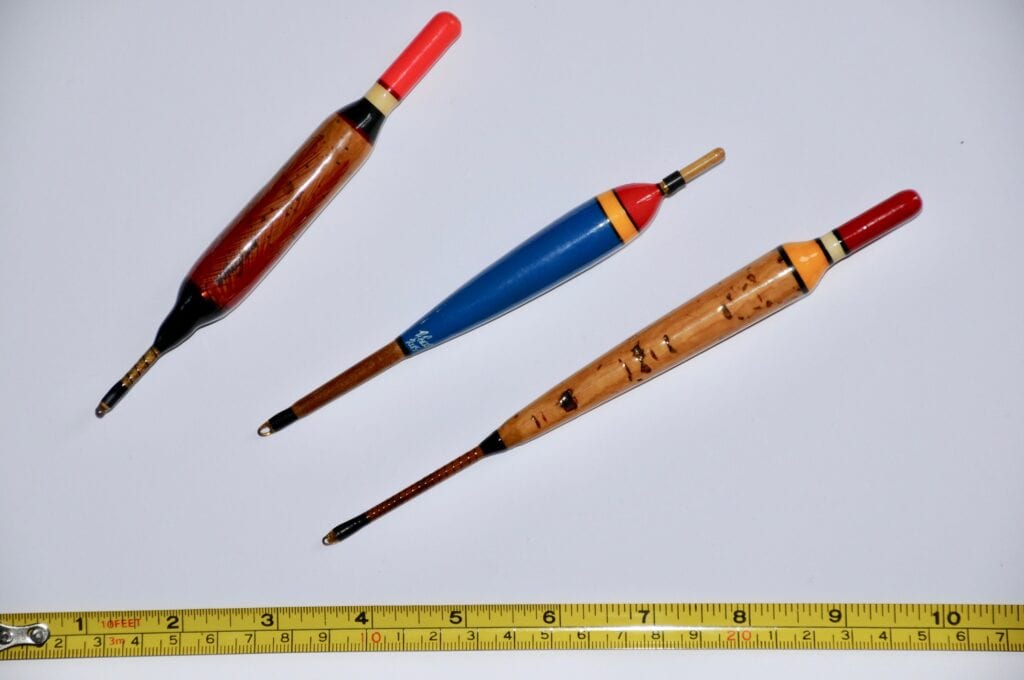
I am convinced that pike learn as quickly as any other species. Once pressured, they learn to see, feel and avoid standard pike floats, and that is where smaller, lighter, more streamlined floats like these hand-built jobbies come into their own. I could write a book on my beliefs on this subject, and after years of guiding I feel sure big pike spook like carp, chub or any other species. Small floats are only a part of a newer, lighter approach but worth bearing in mind for sure…
The post Bailey & Coster – Our Way with… Floats first appeared on FishingMagic Magazine.
Continue reading...
BODIED WAGGLERS
Browsing through the vintage float sets on the Thomas Turner website brought back memories of when I first started fishing, recalling quills, perch bobbers, and various other golden oldies. Last year I enjoyed several interesting sessions using another classic float you rarely encounter in tackle shops these days: the bodied waggler. I’ve occasionally seen semi-weighted versions employed as sliders, but a once popular application was to have them fixed, for fishing long range on big stillwaters. I did this a lot in Ireland, but due to various circumstances I haven’t been there for a while. However, last year a mate told me about a venue that offers an uncanny similarity to wild Irish lough fishing, only it’s 10 minutes’ drive from East Midlands Airport. Grabbing a handful of my favourite bodied peacock quills, it dawned on me some are well over 30 years old now. I also dusted down my groundbait catapults, waders and platform, gear that had been lying idle for far too long.
DUAL ATTACK

Staunton Harold Reservoir turned out to be perfect for a big waggler attack. Most anglers choose to fish feeder tackle at extreme range for the bream shoals. But the place is heaving with roach and skimmers, which signals busy float sessions to me. On my first visit I set up two waggler rigs. The first was a traditional bodied model to explore further out, while the second was another classic, an insert peacock design for closer in. Both floats were locked on the main line with two big shot either side. My plan was to kick off with the bodied float a good way out, feeding small balls of groundbait by catapult. My lighter set-up was there if I decided to try loose feeding. Big roach often move closer in as sessions progress, preferring the rocky margins on exposed venues, where they feel a lot safer from predators. Get them within loose-feeding range and it’s often possible to cane them. This is another Irish tactic, building a distance swim, and then channelling the fish closer in.
WORKING IT OUT

It pays to spend time searching your swim before fishing with big wagglers at long range. In venues with shallow margins like this one, finding any far-off ridges or ledges where the depth shelves away can make a huge difference. Fish patrol such areas and feed more confidently in them, feeling safer than when they are in open water. I push my hook into a small piece of tungsten putty to depth-find with waggler rigs, finding conventional plummets too heavy to cast properly with bottom-attached floats. Once I know the depth and how far out I’m going to fish, another top trick before putting any feed in, is to bait up and cast out a few times. As you work the tackle through the swim, it lets you know where any surface drift or tow is going to take everything. Very often you need to fish over-depth to keep the hook bait still, so it can take several yards for rigs to settle properly. There’s no point in feeding first and then finding you can’t hold your float in that particular spot!
WHOPPER DROPPER

I’ve experimented with many groundbait catapults over the years, and still don’t think you can beat the original Whopper Dropper, another piece of classic kit. This wide-gape catty and its rigid cup, set in a cradle-style pouch, allows soft balls of groundbait to be fed without breaking up in flight. This is perfect for big waggler fishing. Softer balls of feed disperse as they descend in the water, leaving a secondary lingering cloud, which is far more effective than feeding hard rocks! This tactic keeps the fish interested and grubbing around for longer, also being less likely to spook a feeding shoal. I don’t mind if some groundbait drops a tad short occasionally, because I can check this area out with my lighter insert waggler set-up as the session progresses. If I get bites there, I can try loose feeding, which is often a great way of ending sessions, catching a bigger stamp of roach. With my groundbait approach, I constantly flick water over the mix to keep the balls on the soft side.
CHANGING MENUS

It’s advisable to carry a good selection of bait when exploring big expanses of water with bodied wagglers. I kick off with dark groundbait, heavily laced with casters and hemp. If any skimmers turn up, I can always add some chopped worm and pellets. I find pellets can help if small fish are a problem, feeding less casters and putting extra doses of 2-4mm pellets into my groundbait. I might also experiment with soft hookers. Bream, skimmers, roach and hybrids will all happily accept these, bearing in mind a lot of feeder anglers use pellets and fishmeal groundbaits these days, especially when targeting bream. To begin sessions, I feed small balls of groundbait every chuck, but once bites start coming, I tend to make it every other cast. It all depends on how the fish are responding. Roach normally stay put once they get used to regular groundbait going in, but skimmers and bream often require a less frequent groundbait approach, being easily spooked in shallow water.
ALL ACTION

It quickly became clear why this reservoir is so popular. As soon as some feed started going in it was virtually a bite a chuck, but the trick was finding how to connect with the bigger fish. Typically for a clear-water venue, the better-sized roach were masters at giving phantom bites, where the float tip slowly went under and nothing was there on the strike. But it soon became apparent my big-bodied wagglers hadn’t lost any effectiveness over the decades. I had to fish well over-depth, with my lowest dropper shot dragging hard on the bottom to steady the hook bait. Double red maggots pulled too many small fish, but a switch to single dark casters brought a better stamp of roach and hybrids. The same pattern emerged over three different visits, where the trick was to try and get hook baits through the bits, casting a few yards from where any groundbait was going in, then letting the tow pull the tackle into the taking area. Soft, dark pellets pulled bites too.
STILL EFFECTIVE

The last time I enjoyed quality waggler fishing with this tactic was across the Irish Channel several years ago, fishing Cork’s Inniscarra Reservoir. Pristine red fins provided great sport at a hectic rate back then and I caught some cracking fish. I found a similar attack with small balls of catapulted groundbait worked the same here. On my first bodied waggler outing I also managed to loose feed over the top, because the wind was from behind. But my swim choice turned out to be very shallow, just 4 feet deep. Fish were there, but no real chance of skimmers or bream in that depth. I caught steadily though. Towards the end I plundered some bigger roach on the insert waggler, dragging well over depth – several metres closer in than where I started. On my next trip, I picked a deeper area and managed to keep fish coming all day on the distant bodied waggler feed line, hoping for bream to turn up. They didn’t, and it was mainly roach again, plus a few surprise dace.
HOOKED AGAIN

I managed a final trip to the reservoir before winter descended, by this time completely absorbed by this bodied waggler technique. It’s a positive way of fishing that gets in your blood. It takes time getting back in the swing of putting balls of groundbait within inches of your float tip, or just ahead of it when you need to let any drift shift your rig into the taking area. Because this venue was shallow, I found a 13ft float rod ideal. For deeper water and similar slider fishing at distance, I would have no hesitation switching to 14ft or even 15ft rods. I often use the same semi-loaded bodied wagglers for fixed fishing as I do for slider applications. With some weight built into these floats, you don’t need massive amounts of shot to lock them, avoiding making rigs over-complicated. I have doctored many of my bodied floats, aralditing in connectors, so different coloured hollow tips can be switched around to suit light conditions. Yet another action-packed session followed.
IN THE BEGINNING

In many cases, modern pellet wagglers and carp splashers have replaced good old bodied wagglers, which were even used for carp many years ago. I remember Bob Cheeseman, a fellow Essex County team member, landing some massive carp with them on Layer Pits. Even before that, during my club fishing days, I recall being pegged opposite a top angler on a lake at London Colney, watching the guy expertly casting a bodied waggler next to a far-off lily bed. He made it all look so easy as he cranked in bream after bream. It was an education. Since then, over several decades I have built up a good collection of bodied floats, some home-made, some doctored, some shop-bought, some crafted by other anglers. As I mentioned earlier, they were mostly used when I regularly visited Ireland, so I’m a bit like a kid in a toyshop now I have rediscovered these floats. Some are works of art and like JB says, a bit scary to use in case they get lost. This good skimmer was taken on one.
GETTING THERE

While my rediscovered attacking floats couldn’t line the skimmers and slabs up on the reservoir, I did plunder the roach stocks. Catching quality red fins is tricky on many cormorant-ravaged big stillwaters these days, but somehow the fish here were managing to survive. Maybe having plenty of anglers about was a plus factor, along with the sailing club that was possibly helping to keep the predators at bay. My final session at Staunton Harold, which is a day ticket water, turned into another bite a chuck experience. Once again, casters found the better roach, but they wouldn’t come within loose feeding range. It had to be groundbait: every cast to quickly bring the peg alive, then every other cast when things were ticking over. I tried worms and caught that one good skimmer, but possibly wasn’t quite bold enough, not going far enough out to string more together. But now I’ve got back in the swing of it, I reckon I can push this method much further.
BAGGING UP

I had forgotten how good bodied waggler fishing could be. I spent many years up North, where all my big semi-weighted designs could only be used as sliders, because all the larger venues were too deep for fixed floats. But now I’m living in the Midlands, there are plenty of shallower places where I can use the method again. Getting back in the groove of casting and catapulting groundbait accurately at extreme waggler range brings a satisfying feeling, especially when a decent bite develops nearly every time. It’s a busy way of fishing, as you can see from this catch of mainly quality roach. Nowadays, just about everyone on big venues is casting to the horizon with feeders, so I wonder if largely forgotten floats, like I’ve been using, might make a comeback? I certainly keep a good supply in with my gear now, looking forward to using the method a lot more. I did manage another session, on a venue with better chances of finding bream within range of my groundbait catty…
WORKING WONDERS

Yet another big stillwater, with sensible depths of around 6-8ft, was perfect for a fixed bodied waggler attack. Apart from this fine trio, I also caught loads of roach, hybrids and smaller skimmers, for a smashing net of fish. Rediscovering forgotten floats has highlighted they can still work perfectly well. Other golden oldies in my collection include some Benny Ashurst and early Pete Warren sticks, remember those? I also have some Tom Pickering peacock inserts, one or two Billy Makin Canal Greys, a few Image Canal Wagglers and even some old Middy specials with my name printed on them. I can’t remember what that was about! Peter Drennan is another great float maker and I still have his early Crystal Wagglers, along with Merged Peacock inserts, which were best sellers for many years. And yes, JB, I too have used matchsticks and bits of quill along the way!
John Bailey – My Way with Floats
My very early angling life in the Fifties revolved around floats, like everyone’s did, come to that. Legering was seen as iffy, lazy, a poor substitute for the real thing and as a last resort. We all remember the tackle shops of the day, counters a colourfully resplendent feast of jars packed with quills of all sorts and sizes, floats for every occasion. If you could afford them. Most sessions began with my mates and me rummaging on the canal towpaths looking for half-decent matchsticks to do the job, both cheaply and efficiently, as it happened. Then, by the later Sixties and into the Seventies as floppy hats, forceps and specimen hunting came in, floats somewhat went out. It wasn’t until the later Nineties and this century that I personally came back to floats with such a gleeful vengeance. In part this was because, as a guide, my clients in the main preferred to float fish, but then I too began to see the sense in the reversion. Float fishing is inherently “nicer” than legering, more engaging, more appealing, more all-consuming. It is efficient as well, and there is truly a float for every occasion, and that knowledge is what gives the float its versatility, as I hope to prove today.

In the Nineties I wrote a little book called Perfect your Float Fishing and that hastened my conversion back to the true faith. I was helped massively by float maestro Peter Drennan, so I had the way paved for me magnificently. Since then, I have become friends with legendary float makers like Paul Cook, Ian Lewis and Andy Field, and many of my floats come from their workshops. Of course, like all of us, most of my floats are plastic Drennans, but there are specialised jobs where a float of individuality can make the task easier. Of course, there is the cost factor and I’m well aware it’s not good to lose a forty quid float up a tree first cast, then its twin on a weeded carp half an hour later but, honest, if I’m a couple of floats down at the end of an average season then that’s unusual. (Mind you, I’ll swim for a Field float if I have to!) eBay can cough up some gems, as can car boot sales, and there are some crackers on the Thomas Turner website. But I’m not in the business of selling floats for anyone here today, just talking about the more unusual floats that serve me well in an average season. And don’t forget, if you don’t have pork sausages for fingers like me, you can make your own floats too. I believe Ian Lewis sells kits to get you started, so if there ever is another lockdown – God forbid – you know how to spend it!
BIG WINDBEATERS


There are times when I prefer to fish a float at range rather than use a lead or feeder. Bream, roach, rudd, tench and carp even can get wary of the splash, and a float can present a smaller bait uniquely well. I first used these Field floats at Bucklands, the historic rudd water of a few years back. They didn’t catch me many rudd, but that was my ineptitude and not the fault of the tools. Since then, they have done me well for tench and bream at 30, even 40 yards distance, when both species have become twitchy around the lead.
LAYING ON IN BIGGER RIVERS

I am a slave to laying on in rivers. I was taught the method back on the river Dane around 1961-62, and it has caught me fish I would not get near since then. These floats are the size required for rivers of biggish flow and depth – I find them perfect for the Wye, for example. The key is the buoyancy up top that stops the float constantly sinking under the power of the current. You can get plastics to do the job, but these cane/cork creations don’t seem to skate in the same way, and hold position far better.
BIG SHOULDER STICKS

These are my go-to floats in quick, deep, turbulent water. The big shoulders prevent the float being pulled under repeatedly, and they give me something solid to mend the line against without pulling the float off course. They are perfect for chub and barbel both, and did me well on the Avon at Longford back in the happiest of days.
DOMED STICKS

Andy Field made me a whole set of these beauties, and I have bought some more since, nearly as good. They work much like the Big Shoulders but are a little more sensitive, and great for smoother water. In their small sizes they worked well on very sensitive upper rivers like the Wensum, Bure and Yare. I have lost these, as it happens, and there are times I do miss them. It’s easy to get precious about floats and sound a real geek, but sometimes, small changes in model can make the difference.
IAN LEWIS AVONS

I fish these a lot. They are relatively inexpensive and I do lose a few fishing at range, especially when guiding them close to snags. But that’s their beauty, getting big slabs of flake forty yards down quick water 4 to 8 feet deep, and always maintaining control… well, most of the time anyway.
THE PHIL HUMM INFLUENCE

Phil is a dear friend and a cracking float man, and years ago made me the big, fluted balsa jobby in the photograph. I seem to remember it was made for a massive glide on the Wye where you needed to get big baits half the way to the sea to locate the chub. The thing takes half a dozen SSGs (at least), but you can see it and control it a mile off. I seem to recollect catching chub at a measured 80 yards plus the first time I tried it. Phil has never been afraid of using big floats if the job requires them, and that is why Andy Field made up the Phil Humm Town Centre Stick Float for him. God knows how much weight it takes as I have never actually used the thing, but I can see it working on the tidal Thames, for example. Didn’t the Trent Otter construct something similar for the lower Trent a century back, a creation that could carry nine ounces of weight or thereabouts? Men were certainly men back then!
IAN LEWIS REEDS

Ian made me a whole load of these nifty little reed floats, and put them in a dinky case that stops me losing them. Come summer, on little rivers, they are my go-to. Most take a BB, sometimes two, and you can tease them through quiet, shallow water beautifully.
ULTRA-LIGHT WENSUM WORK

Mind you, there are numerous times when even these reed jobbies are too much. Ian made me some actual painted-up matchsticks that were brilliant, and took me back to the Macclesfield canal, but I have lost the damn things. Pole floats do as well, fished on running line in my case. Tiny quills. Often a number 6 shot is all the swim will stand, believe me.
NOVELTY NONSENSE THAT WORKS

In 2012 I took Andy Field to India with me and he made these gorgeous floats up for everyone in the group… and wasn’t too excited to find a couple put on eBay shortly after our return. Anyway, they did serve a purpose and caught smaller mahseer by trotting balls of ragi paste anything up to 70 yards away. Fun! But it was the JB Jack Action Float that raised eyebrows! I had (and still have) a hunch that on some pike waters there are very big fish living unsuspected lives, simply because they have switched to a diet of smaller jacks. Of course, you can fish these on the bed, but there are times when a dead jack suspended is preferable. Naturally, use of this float was always a rarity, but when a dead jack turned up, often deeply hooked by someone and left to die in the margins, it had its moments. I can recall at least three big twenties coming its way.
LIGHT PREDATOR FLOATS

I am convinced that pike learn as quickly as any other species. Once pressured, they learn to see, feel and avoid standard pike floats, and that is where smaller, lighter, more streamlined floats like these hand-built jobbies come into their own. I could write a book on my beliefs on this subject, and after years of guiding I feel sure big pike spook like carp, chub or any other species. Small floats are only a part of a newer, lighter approach but worth bearing in mind for sure…
The post Bailey & Coster – Our Way with… Floats first appeared on FishingMagic Magazine.
Continue reading...
